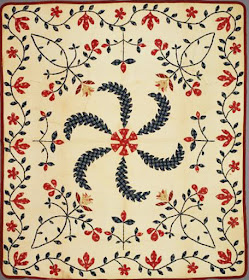1797, Hannah John. Documented by the Maine Project.
One of my quilt history goals last year was to develop an accessible internet file of quilts with dates inscribed on them. I created Pinterest pages for each year or decade from 1775 to 1860. Date-inscribed quilts give us insight into how style, fabric and techniques came in and out of fashion.
Here's a link to the oldest quilts from 1775 to 1800:
This year my goal was to analyze those images between 1775 & 1860 and draw some conclusions. I've looked at a lot of chintz appliques.
Quilt dated 1826 by Sarah Harris Gilmer
Documented in the North Carolina Project
Analysis is always more complex than sorting and saving and I have not clarified many conclusions that were not obvious when I began. For example, red and green quilts date to the 1840s.
1842, Elizabeth Shank, Rogerville, Ohio
Collection: Daughters of Utah Pioneers Museum
I'm still working on it.
As with any data set there are outliers---quilts that are the earliest or the latest example of a style or technique.
Typical household linen marking stitch on the
reverse of Elizabeth Nace's nine patch quilt
Dated 1786, Elizabeth Bowman Nace (ca. 1740-1815)
Hanover, Pennsylvania. Lancaster Historical Society
Among the earliest American quilts, one of perhaps five dated before 1790.
Looking at some of the outliers in the data I wonder if there is a big flaw in my reliance on date-inscribed pieces because the date on the quilt might not be when the patchwork was done. It might be the date on a pre-existing backing or supporting fabric. In this case, an old linen sheet cut up and saved in the backing.
Marking sheets with cross stitch embroidery and a number was considered good housekeeping. This marking "L N 13" on the reverse of a nine patch strip quilt indicates the backing was an old sheet recycled.
From online dealer gb-best
Housekeepers often dated their linens, their sheets and blankets. Sometimes these pieces were transformed into another piece of bedding, a patchwork quilt. A linen sheet dated 1786 might be used to back a cotton quilt in 1810.
1809, Quilt by Elizabeth Stouffer Garrett, (1791-1877)
Baltimore Museum of Art
The quilt is dated 1809 in cross stitch on the back with the initials E.S. and the number 7.
If made in 1809 this quilt is a significantly early example of a tree of life chintz quilt. (See Sarah Gilmer Harris's 1826 quilt above.) It's been puzzling me ever since I first saw it in William Dunton's 1945 book. Could the date be on a re-purposed backing?
On the other hand the Baltimore Museum of Art has other Garrett family quilts with the same kind of inscription on the backing, indicating the Garretts marked their quilts like their sheets.
See a blog post on the Garrett quilts:

Those of us who see early quilts only in photographs are not aware that many cut-out chintz applique pieces feature chintz prints stitched to a machine woven blanket, as in this detail from a Skinner auction. We tend to think of the backing as plain weave cotton purchased just for the patchwork but that is not the case in many early 19th century quilts in the U.S. and the U.K.
Center of a frame quilt with a date of 1824 directly above the large
oval in the panel. It's probably British.
"Ann Price
1824"
The inscription indicates this is one of the earliest quilts in the files Merikay Waldvogel and I are keeping of this particular panel #1. But that date seems to have been on the base fabric, a re-used blanket perhaps.This piece also has some mid-20th century repairs---definitely a time span quilt.
Collection of Gawthorpe Textile Collection
"E I 1812"
Another British quilt, this one dated 1812 and initialed E I, skews our data on panel quilts with an early date. Without the date we'd guess 1820s. But is the date of the supporting fabric?
Did someone applique panels, hexagons and flowers atop an old linen sheet?
The central embroidery with the framing lappets is thought to be an 18th-century piece saved in the later bedcover---but how late?
This piece skews our data early, not only in its use of specific panels but in use of panels at all. Because panel production is now thought to be from the mid-teens we can wonder if the date on the patchwork bedcover actually refers to the base fabric.
Most of this post is speculation but it does give one a different perspective
on early quilts and the sources of the materials.





















































